Apple Store
Apple Store is a chain of retail stores owned and operated by Apple Inc. The stores sell various Apple products, including Mac personal computers, iPhone smartphones, iPad tablet computers, iPod portable media players, Apple Watch smartwatches, Apple TV digital media players, software, and selected third-party accessories.
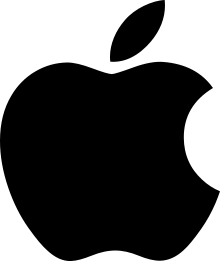 | |
| Subsidiary | |
| Industry |
|
| Founded | May 19, 2001 Tysons, Virginia, United States |
| Founder | Steve Jobs |
| Headquarters | United States |
Number of locations | 511 locations[1] (271 US/238 overseas) |
Key people |
|
| Products |
|
| Parent | Apple Inc. |
| Website | www |
The first Apple Stores were originally opened as two locations in May 2001 by then-CEO Steve Jobs, after years of attempting but failing store-within-a-store concepts. Seeing a need for improved retail presentation of the company's products, he began an effort in 1997 to revamp the retail program to get an improved relationship with consumers and hired Ron Johnson in 2000. Jobs relaunched Apple's online store in 1997 and opened the first two physical stores in 2001. The media initially speculated that Apple would fail, but its stores were highly successful, by passing the sales numbers of competing for nearby stores and within three years reached US$1 billion in annual sales, becoming the fastest retailer in history to do so. Over the years, Apple has expanded the number of retail locations and its geographical coverage, with 506 stores across 25 countries worldwide as of 2018.[2] Strong product sales have placed Apple among the top-tier retail stores, with sales over $16 billion globally in 2011.
In May 2016, Angela Ahrendts, Apple's then-Senior Vice President of Retail, unveiled a significantly redesigned Apple Store in Union Square, San Francisco, featuring large glass doors for the entry, open spaces, and rebranded rooms. In addition to purchasing products, consumers can get advice and help from "Creative Pros" – individuals with specialized knowledge of creative arts; get product support in a tree-lined Genius Grove; and attend sessions, conferences, and community events, with Ahrendts commenting that the goal is to make Apple Stores into "town squares", a place where people naturally meet up and spend time. The new design will be applied to all Apple Stores worldwide, a process that has seen stores temporarily relocate or close.
Many Apple Stores are located inside shopping malls, but Apple has built several stand-alone flagship stores in high-profile locations. It has been granted design patents and received architectural awards for its stores' designs and construction, specifically for its use of glass staircases and cubes. The success of Apple Stores has had significant influence over other consumer electronics retailers, who have lost traffic, control and profits due to perceived higher quality of service and products at Apple Stores. Apple's notable brand loyalty among consumers causes long lines of hundreds of people at new Apple Store openings or product releases. Due to the popularity of the brand, Apple receives many job applications, many of which come from young workers. Apple Store employees receive above-average pay, are offered money toward education and health care, and receive product discounts; however, there are limited or no paths of career advancement. A May 2016 report with an anonymous retail employee highlighted a hostile work environment with harassment from customers, intense internal criticism, and a lack of significant bonuses for securing major business contracts.
Overview
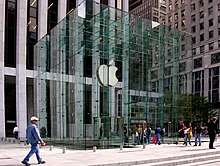
Many Apple Stores are located inside shopping malls, but Apple has built several stand-alone flagship stores in high-profile locations, such as the one located in Grand Central Terminal in New York City.[3] Several multi-level stores feature glass staircases,[4][5][6] and some also glass bridges.[7] The New York Times wrote in 2011 that these features were part of then-CEO Steve Jobs' extensive attention to detail,[8] and Apple received a design patent in 2002 for its glass staircase design.[9][10][11] Historically, Apple has partnered with architectural firm Bohlin Cywinski Jackson in designing and creating its original retail stores, and has in recent years partnered with architectural firm Foster + Partners in designing its newer stores, as well as its corporate Apple Park campus.[12]
Apple has received numerous architectural awards for its store designs,[13][14] and its "iconic" glass cube, designed in part by Peter Bohlin,[15][16] at Apple's Fifth Avenue store in New York City, received a separate design patent in 2014.[17][18][19]
Ron Johnson held the position of Senior Vice President of Retail Operations from 2001 until November 1, 2011.[20][21] During his tenure, it was reported that while Johnson was responsible for site selection, in-store service, and store layout, inventory was controlled by then-COO and now-CEO Tim Cook, who has a background in supply chain management.[22] In January 2012, Apple transferred retail leadership to John Browett.[23] However, after attempts to cut costs, including reducing new hires and limiting staff hours, he was fired after six months, later telling a conference that he "just didn’t fit with the way they ran the business".[24][25] In October 2013, Apple hired Angela Ahrendts from Burberry.[26][27][28]
Work environment
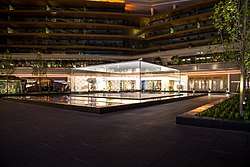
Due to the popularity of the brand, applicants for jobs at Apple Stores are numerous, with many young workers applying.[29] The pace of work is high due to the popularity of the iPhone and iPad.[29] Employees typically work for only a few years as career prospects are limited with no path of advancement other than limited retail management slots.[29] Apple Store employees make above-average pay for retail employees and are offered money toward college tuitions, gym memberships, health care, 401(k) plans, product discounts, and reduced price on purchase of stock.[29] The retention rate for the technicians who staff the Genius Bar is more than 90%.[29][30]
A May 2016 Business Insider article features a lengthy interview with an anonymous Apple Store retail worker in the United Kingdom, where the employee highlighted significant dissatisfactions and issues for retail workers, including harassment and death threats from customers, an intense internal criticism policy that feels "like a cult", a lack of any significant bonus if a worker manages to secure a business contract worth "hundreds of thousands", a lack of promotion opportunities, and are paid so little that many workers are unable to buy products themselves even with a "generous" discount on any Apple product or Apple stock.[31]
Countries and regions
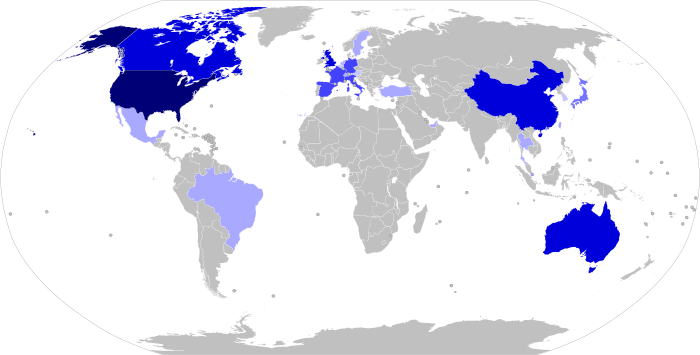
| # | Country / Region | Date of first store | First store location | Number of stores | Reference |
|---|---|---|---|---|---|
| 1 | United States | May 19, 2001 | Tysons Corner Center, Tysons Corner, Virginia | 271 | [32] |
| 2 | Japan | November 30, 2003 | Ginza, Tokyo | 10 | [33] |
| 3 | United Kingdom | November 20, 2004 | Regent Street, London | 38 | [34] |
| 4 | Canada | May 21, 2005 | Yorkdale Shopping Centre, Toronto | 29 | [35] |
| 5 | Italy | March 31, 2007 | Centro Commerciale Roma Est, Rome | 17 | [36] |
| 6 | Australia | June 19, 2008 | George Street, Sydney | 22 | [37] |
| 7 | China | July 19, 2008 | Sanlitun, Beijing | 42 | [38] |
| 8 | Switzerland | September 25, 2008 | Rue de Rive, Geneva | 4 | [39] |
| 9 | Germany | December 6, 2008 | 1 Rosenstrasse, Munich, Bavaria | 15 | [40] |
| 10 | France | November 7, 2009 | Carrousel du Louvre, Paris | 20 | [41] |
| 11 | Spain | September 4, 2010 | La Maquinista, Barcelona | 11 | [42] |
| 12 | Hong Kong | September 24, 2011 | IFC Mall | 6 | [43] |
| 13 | Netherlands | March 3, 2012 | Hirschbuilding, Leidseplein, Amsterdam | 3 | [44] |
| 14 | Sweden | September 15, 2012 | Täby Centrum, Stockholm | 3 | [45] |
| 15 | Brazil | February 15, 2014 | VillageMall, Barra da Tijuca, Rio de Janeiro | 2 | [46] |
| 16 | Turkey | April 5, 2014 | Zorlu Center, Istanbul | 2 | [46] |
| 17 | Belgium | September 19, 2015 | Avenue de la Toison d’Or, Brussels | 1 | [47] |
| 18 | United Arab Emirates | October 29, 2015 | Mall of the Emirates, Dubai; Yas Mall, Abu Dhabi |
3 | [48] |
| 19 | Macau | June 25, 2016 | Galaxy Macau | 2 | [49] |
| 20 | Mexico | September 24, 2016 | Centro Santa Fe, Santa Fe, Mexico City | 2 | [50] |
| 21 | Singapore | May 27, 2017 | Orchard Road | 2 | [51] |
| 22 | Taiwan | July 1, 2017 | Taipei 101, Taipei | 2 | [52] |
| 23 | South Korea | January 27, 2018 | Garosu-gil, Gangnam, Seoul | 1 | [53] |
| 24 | Austria | February 24, 2018 | Kärntner Straße, Vienna | 1 | [54] |
| 25 | Thailand | November 10, 2018 | Iconsiam, Bangkok | 2 | [55] |
History
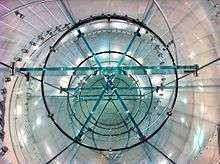
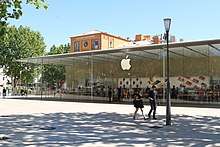
Third-party retail
Steve Jobs, co-founder of Apple, returned to the company as interim CEO in 1997. According to his biographer Walter Isaacson, Jobs began a concerted campaign to help sales by improving the retail presentation of Macintosh computers. Even with new products launched under his watch, like the iMac and the PowerBook G3 and an online store, Apple still relied heavily on big-box computer and electronics stores for most of its sales. There, customers continued to deal with poorly trained and ill-maintained Mac sections that did not foster customer loyalty to Apple and did not help differentiate the Mac user experience from Windows.[56][57] In fact, the retailer trend was towards selling their own generic in-house brand PCs which used even cheaper components than those by major PC makers, increasing retailer overall margins by keeping the manufacturing profits. This "provided a powerful profit motive to convert customers interested in buying a Mac into the owners of a new, cheaply assembled, house brand PC".[58]
Tim Cook, who joined Apple in 1998 as Senior Vice President for Worldwide Operations, announced the company would "cut some channel partners that may not be providing the buying experience [Apple expects]. We're not happy with everybody." Jobs severed Apple's ties with every big box retailer, including Sears, Montgomery Ward, Best Buy, Circuit City, Computer City, and Office Max to focus its retail efforts with CompUSA. Between 1997 and 2000, the number of Mac authorized resellers dropped from 20,000 to just 11,000. The majority of these were cuts made by Apple itself. Jobs proclaimed that Apple would be targeting Dell as a competitor, with Cook's mandate to match or exceed Dell's lean inventories and streamlined supply chain. Jobs made an open statement to Michael Dell, "with our new products and our new store and our new build-to-order, we're coming after you, buddy." While Dell had operated as direct mail order and online order company, having pulled out of retailers to realize greater profit margins and efficiency, Apple had direct orders with sales handled by its channel partners, other mail order resellers, independent dealerships, and the new relationship with CompUSA to build "stores within a store".[58]
Jobs did a study for stand-alone "store within a store" for 34 sites in Japan. These sites were designed by Eight Inc. and CEO Tim Kobe[59] who was designing the Apple MacWorld and product launch events with Apple. CompUSA was one of the few retailers that kept its Apple contract by agreeing to adopt Apple's "store within a store" concept designed by Eight Inc. This required that approximately 15% of each CompUSA store would be set aside for Mac hardware and software (including non-Apple products) and would play host to a part-time Apple salesperson. However, the "store within a store" approach did not meet expectations, in part because the Apple section was in the lowest-traffic area of CompUSA stores. CompUSA president Jim Halpin, who proclaimed that he would make Apple products his top priority, was forced to resign a year later. Also, CompUSA had trouble finding well-trained staff, as most store clerks usually steered customers away from Macs and towards Windows PCs. Through these setbacks, CompUSA sales of Macs had increased. Apple then added Best Buy as a second authorized reseller.[60] Challenges still remained, as resellers' profit margins on selling Macs was only around 9%, and selling Macs was only worthwhile if ongoing service and support contracts were provided, of which retailer experiences were inconsistent.[61]
Online store
In 1997, the year Steve Jobs returned to Apple, Dell founder and CEO Michael Dell were asked how he would fix Apple. Dell responded: "I'd shut it down and give the money back to the shareholders". This angered Jobs, due to Dell's success with its online store originally built by NeXT, his former business that Apple acquired to bring Jobs back. A team of Apple and NeXT employees spent several months building an online store that would be better than Dell's. On November 10, 1997, Steve Jobs announced the online store at an Apple press event, and during his keynote speech, he said: "I guess what we want to tell you, Michael, is that with our new products and our new store and our new build-to-order manufacturing, we're coming after you, buddy."[62]
In August 2015, Apple revamped the online storefront, removing the dedicated "Store" tab and making the entire website a retail experience.[63][64]
Origins
Jobs believed the Apple retail program needed to fundamentally change the relationship to the customer, and provide more control over the presentation of Apple products and the Apple brand message. Jobs recognized the limitations of third-party retailing and began investigating options to change the model.[3]
In 1999, Jobs personally recruited Millard Drexler, former CEO of Gap Inc., to serve on Apple's board of directors.[3][65][66] In 2000, Jobs hired Ron Johnson from Target. The retail and development teams headed by Allen Moyer from The Walt Disney Company then began a series of mock-ups for the Apple Store inside a warehouse near the company's Cupertino headquarters.[3]
On May 15, 2001, Jobs hosted a press event at Apple's first store, located at the Tysons Corner Center mall in Tysons, Virginia near Washington, D.C.[67] The store officially opened on May 19, along with another store in Glendale Galleria in Glendale, California.[67][3][68] More than 7,700 people visited Apple's first two stores in the opening weekend, spending a total of US$599,000.[69]
Expansion
Several publications and analysts predicted the failure of Apple Stores. However, the Apple retail program established its merits, bypassing the sales-per-square-foot measurement of competing nearby stores, and in 2004 reached $1 billion in annual sales, the fastest of any retailer in history. Sales continued to grow, reaching $1 billion a quarter by 2006. Then-CEO Steve Jobs said that "People haven't been willing to invest this much time and money or engineering in a store before", adding that "It's not important if the customer knows that. They just feel it. They feel something's a little different."[70] In 2011, Apple Stores in the United States had an average revenue of $473,000 for each employee.[29] According to research firm RetailSails, the Apple Store chain ranked first among U.S. retailers in terms of sales per unit area in 2011, almost doubling Tiffany, the second retailer on the list.[29] On a global level, all Apple Stores had a combined revenue of US$16 billion.[29] Under the leadership of Ron Johnson, the former senior Vice President of Retail Operations, the Apple Stores have, according to an article in The New York Times, been responsible for "[turning] the boring computer sales floor into a sleek playroom filled with gadgets".[71] The Apple Stores have also been credited with raising the company's brand equity, with Scott Galloway, Professor of Marketing at New York University Stern School of Business, stating that the Stores are the "temple to the brand which is this unbelievable experience called an Apple Store, and then you have this very mediocre experience called an AT&T or Verizon connect your phone experience for Samsung and the other Android players".[72]
Apple has since re-established ties with major big box retailers like Best Buy and Staples.[73] Authorized Apple resellers have a dedicated store-within-a-store section, offering a distinctive Apple-style experience to showcase products.[74] The relationship with Best Buy calls for the company to send Apple Solutions Consultants (ASCs) to train Best Buy employees to be familiar with Apple's product lineup.[57][75]
Influence
Apple Stores have considerably changed the landscape for consumer electronics retailers and influenced other technological companies to follow suit. According to The Globe and Mail, "Apple’s retail stores have taken traffic, control and profits away from Verizon as well as electronics retailers, such as Best Buy, that once looked at wireless phones as a lucrative profit source".[76] CNET has reported that the "Apple retail experience hurts Best Buy" and noted, "Buy a MacBook at the Apple Store and it's hard to go back to the Best Buy Windows laptop buying experience". The publication also wrote that "Apple salespeople are generally more knowledgeable, the products themselves are generally higher quality, and the stores are more appealing, aesthetically and practically."[77]
In October 2009, reports surfaced that Steve Jobs and his retail team would help "drastically overhaul" Disney Stores. His involvement was described by The New York Times as "particularly notable", given his work on the "highly successful" Apple Stores and his election to Disney's board of directors in 2006.[78][79]
In August 2009, London Evening Standard reported that Apple's first store in the United Kingdom, at Regent Street, was the most profitable shop of its size in London, with the highest sales per square foot, taking in £60 million a year, or £2,000 per square foot.[80]
Many other electronics retailers from around the world such as Huawei, Samsung, Xiaomi started to follow the designing trend of Apple Store.
Redesign
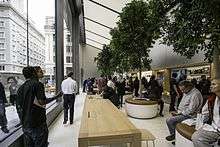
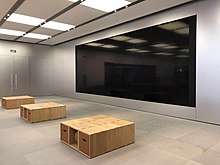
In May 2016, Apple significantly redesigned its Union Square Apple Store in downtown San Francisco, adding large glass doors for the entry, open spaces with touch-sensitive tables and shelves for product displays, and rebranded rooms for the store. "The Avenue" is the central location for hardware, as well as for receiving advice from salespersons and "Creative Pros" with specialized knowledge of music, photography, creativity, and apps. The "Genius Bar" becomes the "Genius Grove", a tree-lined area for help and support. "The Forum" features a large video screen and offers game nights, sessions with experts in creative arts, and community events. "The Plaza", while limited to select locations, offers a "park-like" space outside the store featuring free 24/7 Wi-Fi access and will host live concerts on some weekends.[81][82] Designed by Jony Ive and Angela Ahrendts, the idea was to make Apple Stores into "town squares", in which people come naturally to the store as a gathering place,[83] and to "help foster human experiences that draw people out of their digital bubbles".[84] The new design will be adopted to every store Apple has,[85] and while renovation is undergoing, stores are either relocated[86] or temporarily closed.[87]
In April 2017, Apple announced that its "Today at Apple" educational sessions, which launched with its Union Square redesign in 2016 and offer more than 60 free hands-on sessions for creative skills, will also be expanded to all of its stores.[88][89]
Starting May 2018, a Video Wall was added to stores around the world, and upgrade some stores like Apple Palo Alto.[90]
Genius Bar
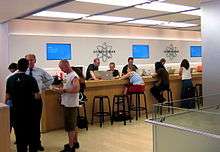
All Apple Stores feature a Genius Bar, where customers can receive technical advice or set up service and repair for their products. The Genius Bar provides hardware service on products that are not classified vintage or obsolete.[91] However, in most cases the Geniuses will at least attempt to assist customers with older hardware.[92]
In May 2017, Apple launched a new program called Today At Apple. Customers can come in and receive free training from a Creative in more than 60 different sessions. Topics include basic device knowledge, Apple's professional film, and music editing software, coding for kids, and tools for using Apple products in classroom-based learning.[93]
The largest Genius Bar in the world is located in Amsterdam.[94]
Store openings
Apple Store openings and new product releases can draw crowds of hundreds, with some waiting in line as much as a day before the opening.[95][96][97][98] The opening of New York City's Fifth Avenue Cube store in 2006 became the setting of a marriage proposal, and had visitors from Europe who flew in for the event.[99] In June 2017, a newlywed couple took their wedding photos inside the then-recently opened Orchard Road Apple Store in Singapore.[100][101]
Apple Company Store
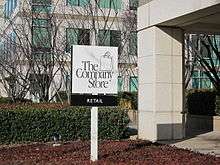
In 1993, Apple opened a store at its Apple Campus in Cupertino, California. At the time, the store was the only place in the world where Apple merchandise could be purchased, including T-shirts, mugs, and pens.[102] In June 2015, the store was closed for renovations,[103] and in September it was reopened, offering a new design and, for the first time, selling iPhones.[104][102][105]
Imitations
In July 2011, an American expatriate blogger who lives in the southwestern Chinese city of Kunming reported on her discovery of what she called "the best ripoff store we had ever seen"—a fake Apple Store, complete with the glass exterior, wood display tables, winding staircase and large promotional posters found in legitimate Apple Stores, and with employees wearing lanyards and the same T-shirts as actual Apple Store employees.[106] The Wall Street Journal reported that the store had "gotten widespread international attention for the remarkable lengths to which its proprietors seem to have gone to mimic the look and feel of a real Apple Store."[107] The fake Apple Store was mentioned by U.S. presidential contender Mitt Romney in the second 2012 election debate.[108] Chinese law prohibits retailers from copying the look and feel of competitors' stores, but enforcement is lax.[109]
According to The Wall Street Journal, unauthorized Apple resellers are found throughout China; the blogger's original post noted that two such stores were located within walking distance of the first knockoff, one of them with a misspelled sign reading "Apple Stoer".[107] An employee of the first knockoff confirmed that the store was not one of the 13[109] authorized Apple resellers in Kunming.[106][107] In a follow-up report, Reuters indicated that local authorities in Kunming had closed two fake Apple Stores in that city due to lack of official business permits, but allowed three other such stores to stay open, including the one that had attracted international attention. The operators of that store had applied for a reseller license from Apple.[109] At the time of the report, only four legitimate Apple Stores had opened in China, with two in Beijing and two in Shanghai.[107]
See also
References
- "Store List – Apple Store". Apple Inc. Retrieved April 3, 2020.
- "Apple Retail Store - Store List". Apple. Retrieved July 12, 2018.
- "Stores". MacRumors. Retrieved March 23, 2017.
- Weinberger, Matt (May 28, 2016). "Apple spent $1 million on the stairs in the new San Francisco Apple Store". Business Insider. Axel Springer SE. Retrieved March 23, 2017.
- Pierini, David (March 17, 2015). "Step up to 10 incredible, Apple-worthy staircases". Cult of Mac. Retrieved March 23, 2017.
- Diaz, Jesus (July 18, 2012). "The Insanely Huge Glass Panels at the SoHo Apple Store In NY Are Stunning". Gizmodo. Retrieved March 23, 2017.
- "The Top Ten Awe-Inspiring Apple Stores in The World". iGeeksBlog. Retrieved December 6, 2017.
- Helft, Miguel; Carter, Shan (August 25, 2011). "A Chief Executive's Attention to Detail, Noted in 313 Patents". The New York Times. Retrieved March 23, 2017.
- Panzarino, Matthew (April 19, 2012). "Apple out to patent curved glass panels used in Shanghai Retail Store". The Next Web. Retrieved May 6, 2017.
- Noe, Rain (July 17, 2012). "Apple Continues Pushing Boundaries of Glass for Architectural Applications". Core77. Retrieved May 6, 2017.
- "United States Design Patent" (PDF). ifo Apple Store. Archived from the original (PDF) on September 3, 2014. Retrieved May 6, 2017.
- Viladas, Pilar (September 12, 2016). "How Bohlin Cywinski Jackson created the Apple retail experience". Curbed. Vox Media. Retrieved December 6, 2017.
- Hein, Buster (December 12, 2014). "Apple wins supreme engineering award for glass lantern store in Turkey". Cult of Mac. Retrieved May 6, 2017.
- Broussard, Mitchel (February 3, 2016). "Apple Receives Chairman's Award for Historic Architectural Preservation in NYC". MacRumors. Retrieved May 6, 2017.
- Saffron, Inga. "Old-school architect creates an iOpener". The Philadelphia Inquirer. Philadelphia Media Network. Archived from the original on March 24, 2010. Retrieved March 23, 2017.
- Martinelli, Nicole (March 22, 2010). "Apple Cube Store Architect "Computer Illiterate"". Cult of Mac. Retrieved March 23, 2017.
- Linshi, Jack (August 28, 2014). "Apple Wins Patent for Its Glass Cube Store Design". Time. Retrieved May 6, 2017.
- Padilla, Richard (August 28, 2014). "Apple Granted Patent for Fifth Avenue Glass Cube Store Design". MacRumors. Retrieved May 6, 2017.
- Marsal, Katie (August 28, 2014). "Apple wins patent for Steve Jobs-designed Fifth Ave glass cube". AppleInsider. Retrieved May 6, 2017.
- Hodgkins, Kelly (June 14, 2011). "Retail chief Ron Johnson leaves Apple for J.C. Penney". Engadget. AOL. Retrieved May 26, 2017.
- Moren, Dan (June 14, 2011). "Report: Apple retail chief Johnson to depart". Macworld. International Data Group. Retrieved May 26, 2017.
- Lashinsky, Adam (August 25, 2011). "How Apple Works: Inside the World's Biggest Startup". Fortune. Time Inc. Retrieved May 26, 2017.
- "John Browett Joins Apple as Senior Vice President of Retail". Apple Newsroom. Apple Inc. January 30, 2012. Retrieved May 26, 2017.
- Titcomb, James (October 15, 2013). "Why new Apple retail chief's British predecessor John Browett was fired". The Daily Telegraph. Telegraph Media Group. Retrieved May 26, 2017.
- Brian, Matt (October 29, 2012). "Looking back: John Browett's turbulent six months in charge of Apple Retail". The Next Web. Retrieved May 26, 2017.
- Alter, Charlotte (October 15, 2013). "Apple Hires Burberry CEO". Time. Retrieved May 26, 2017.
- Chen, Brian X.; Scott, Mark (October 15, 2013). "Apple Hires Burberry Chief to Polish Image of Online Stores". The New York Times. Retrieved May 26, 2017.
- Butler, Sarah; Rankin, Jennifer; Garside, Juliette (October 15, 2013). "Angela Ahrendts leaves Burberry for new job at Apple". The Guardian. Guardian Media Group. Retrieved May 26, 2017.
- Segal, David (June 23, 2012). "Apple's Retail Army, Long on Loyalty but Short on Pay". The New York Times. Retrieved April 26, 2017.
- Gurman, Mark (June 23, 2012). "New York Times profiles Apple's retail operations and employees". 9to5Mac. Retrieved March 23, 2017.
- Edwards, Jim (May 28, 2016). "NEVER MIND THE DEATH THREATS: An Apple Store worker tells us what it's really like working for Apple". Business Insider. Axel Springer SE. Retrieved May 26, 2017.
- "Apple to Open 25 Retail Stores in 2001". Apple, Inc.
- "Apple Retail Stores, Japan". Apple, Inc. Retrieved May 29, 2020.
- "Apple to Open First Retail Store in Europe on London's Regent Street on Saturday November 20th". Apple, Inc.
- "Canada\'s first Apple Store to open May 21".
- "Apple Media Alert: Apple Apre un Retail Store a Roma - Sabato, 31 Marzo 2007". Apple, Inc.
- "Apple's First Retail Store in Australia Opens in Sydney on Thursday 19 June". Apple, Inc.
- "Apple opens first store in China". July 21, 2008.
- "Apple ouvre un Apple Store à Genève le jeudi 25 septembre 2008". Apple, Inc.
- "Apple opening first German retail store in Munich this weekend".
- "Apple opens doors to France's first Apple Store".
- "Apple Prepares to Open Its First Retail Stores in Spain".
- "Hong Kong Apple Store Opens to Press, Tim Cook to Attend Opening?".
- "Apple's first Amsterdam retail store set to open March 3".
- "Apple to open its first retail store in Sweden September 15th". August 27, 2012.
- "First Apple Store opens to public in Turkey". April 5, 2014.
- "Apple officially confirms first Apple Store in Belgium opens in Brussels on 19th September". September 4, 2015.
- "First UAE Apple Stores to open on Oct. 29, Dubai location could be world's largest".
- "Apple to open first Macau Apple Store on June 25".
- "Apple's grand opening in Mexico". Apple, Inc.
- "Apple Orchard Road opens in Singapore". Apple, Inc.
- "First Apple Store in Taiwan to Open on July 1".
- "가로수길 - Apple Store - Apple (KR)". Apple, Inc.
- "Apple to Open New Retail Store in Vienna, Austria on February 24".
- "Apple Central World opens Friday in Thailand". July 28, 2020.
- Hormby, Tom (May 19, 2008). "The Roots of Apple's Retail Stores". LowEndMac. Retrieved April 26, 2017.
- Meyer, Janet (June 27, 2006). "Best Buy and Apple Together Again". Apple Matters. Retrieved April 26, 2017.
- Eran, Daniel (November 8, 2006). "Apple's Retail Challenge". Roughly Drafted. Retrieved April 26, 2017.
- "Tim Kobe Designed the First Apple Store. He Predicts the Future of Asian Retail". Hive Life Magazine. July 22, 2019.
- Pogue, David (March 1, 1999). "Desktop Critic: CompUSA: Apple's Not-So-Superstore". Macworld. International Data Group. Retrieved March 23, 2017.
- "Apple's Retail Challenge". Retrieved July 21, 2016.
- Fiegerman, Seth (May 16, 2014). "The Slow Evolution of Apple's Online Store". Mashable. Retrieved April 26, 2017.
- Panzarino, Matthew (August 6, 2015). "Apple.com, One Of The World's Biggest Stores, Gets A Redesign". TechCrunch. AOL. Retrieved April 26, 2017.
- Moon, Mariella (August 6, 2015). "Apple's website redesign kills separate 'Store' section". Engadget. AOL. Retrieved April 26, 2017.
- Clover, Juli (January 22, 2015). "Longtime Apple Board Member Mickey Drexler to Retire in March". MacRumors. Retrieved April 26, 2017.
- Warkov, Rita (May 22, 2012). "Steve Jobs and Mickey Drexler: A Tale of Two Retailers". CNBC. NBCUniversal News Group. Retrieved April 26, 2017.
- "Apple to Open 25 Retail Stores in 2001". Apple Press Info. Apple Inc. May 15, 2001. Retrieved April 26, 2017.
- Eadicicco, Lisa (May 19, 2016). "Watch Steve Jobs Introduce the First Apple Store". Time. Retrieved April 26, 2017.
- Edwards, Benj (May 19, 2011). "A tale of two Apple Stores (the first two)". Macworld. International Data Group. Retrieved March 23, 2017.
- Useem, Jerry (March 8, 2007). "Apple: America's best retailer". Fortune. Time Inc. Retrieved April 30, 2017.
- Clifford, Stephanie; Helft, Miguel (June 14, 2011). "Apple Stores Chief to Take the Helm at J.C. Penney". The New York Times. Retrieved March 23, 2017.
- "This 'crazy, irrational decision' Apple made 20 years ago turned out to be the key to its outrageous success over Samsung". Business Insider. Axel Springer SE. October 10, 2017. Retrieved October 11, 2017.
- Gurman, Mark (September 26, 2013). "Apple to expand iPad's reach with Staples deal next month". 9to5Mac. Retrieved March 23, 2017.
- Shaw, Hollie (October 23, 2013). "Best Buy Canada looking to become ground zero in Windows, Apple, Samsung electronics battle". National Post. Postmedia Network. Retrieved May 26, 2017.
- Bangeman, Eric (June 25, 2006). "Apple throwing its weight into Best Buy Mac sales?". Ars Technica. Condé Nast. Retrieved March 23, 2017.
- Simpson, Stephen D. (October 8, 2012). "How Apple's fortunes affect other stocks". The Globe and Mail. The Woodbridge Company. Retrieved May 26, 2017.
- Crothers, Brooke (March 29, 2012). "Is Best Buy following CompUSA, Circuit City to certain doom?". CNET. CBS Interactive. Retrieved May 26, 2017.
- Barnes, Brooks (October 12, 2009). "Disney's Retail Plan Is a Theme Park in Its Stores". The New York Times. Retrieved May 26, 2017.
- McNulty, Scott (October 12, 2009). "NYT: Apple inspiring new Disney retail strategy". Macworld. International Data Group. Retrieved May 26, 2017.
- "Apple store most profitable shop in London for its size". London Evening Standard. August 28, 2009. Retrieved March 23, 2017.
- Webb, Alex (May 19, 2016). "Inside the New Apple Retail Store Design". Bloomberg Technology. Bloomberg L.P. Retrieved April 26, 2017.
- Statt, Nick (May 19, 2016). "Apple just revealed the future of its retail stores". The Verge. Vox Media. Retrieved April 26, 2017.
- Hartmans, Avery (August 19, 2016). "Apple's retail boss wants Apple stores to resemble 'town squares'". Business Insider. Axel Springer SE. Retrieved April 26, 2017.
- Wuerthele, Mike (October 18, 2016). "Angela Ahrendts interview addresses Apple retail refurb, town square concept successes". AppleInsider. Retrieved April 26, 2017.
- "Angela Ahrendts talks Apple store makeover, why Tim Cook hired her". CBS News. CBS. April 25, 2017. Retrieved April 26, 2017.
- Rossignol, Joe (August 19, 2016). "Apple Opening Three Next-Generation Stores Over the Next Week". MacRumors. Retrieved April 26, 2017.
- Rossignol, Joe (February 6, 2017). "Apple Retail Update: Danbury Store Closes for Next-Generation Redesign, Dubai to Get Second Store". MacRumors. Retrieved April 26, 2017.
- Rossignol, Joe (April 25, 2017). "'Today at Apple' Sessions About Art, Music, and Coding Expanding to Every Apple Store in May". MacRumors. Retrieved April 26, 2017.
- Hall, Zac (April 25, 2017). "Apple Store expanding new 'Today at Apple' initiative next month, Angela Ahrendts says [Video]". 9to5Mac. Retrieved April 26, 2017.
- Steeber, Michael (June 30, 2018). "Gallery: Apple's renovated Palo Alto store blends latest retail layout with classic design elements". 9to5Mac. Retrieved June 30, 2018.
- "Official Apple Support". Archived from the original on February 26, 2008. Retrieved July 21, 2016.
- "Old School Genius". Tech Today. 2005. Archived from the original on October 15, 2006. Retrieved October 4, 2006.
- "'Today at Apple' bringing new experiences to every Apple Store". Apple Inc. Newsroom. Retrieved April 9, 2018.
- "Amsterdam Apple Store Now Open to Press, Features World's Longest Genius Bar". MacTrast. March 1, 2012. Retrieved November 1, 2017.
- Webb, Alex; Gurman, Mark; Satariano, Adam (September 16, 2016). "The Apple Store Line Is Dying". Bloomberg Technology. Bloomberg L.P. Retrieved May 25, 2017.
- Kalb, Ira (September 9, 2014). "The Truth Behind The Giant Apple Store Lines". Business Insider. Axel Springer SE. Retrieved May 25, 2017.
- Rossignol, Joe (September 24, 2015). "iPhone 6s Lines Forming at Apple Stores Ahead of Launch Day". MacRumors. Retrieved May 25, 2017.
- Rossignol, Joe (September 19, 2015). "Apple's Beautiful New Store in Brussels Opens to Long Lines and Fanfare". MacRumors. Retrieved May 25, 2017.
- Evans, Jonny (May 22, 2006). "Apple NY opening makes global headlines". Macworld. International Data Group. Retrieved May 25, 2017.
- Ng, Yi Shu (June 14, 2017). "Till death do us dongle: Newlyweds take their Apple obsession to the next level". Mashable. Retrieved June 16, 2017.
- Lang, Cady (June 14, 2017). "This Tech-Obsessed Couple Took Their Wedding Photos in an Apple Store". Time. Retrieved June 16, 2017.
- Bell, Karissa (September 19, 2015). "Inside Apple's redesigned campus store in Cupertino". Mashable. Retrieved May 26, 2017.
- Kahn, Jordan (June 2, 2015). "Apple's iconic company store is closing its doors next week for a major redesign". 9to5Mac. Retrieved May 26, 2017.
- Nieva, Richard; Tibken, Shara (September 18, 2015). "Apple relaunches campus store – and you can buy an iPhone there now". CNET. CBS Interactive. Retrieved May 26, 2017.
- Moyer, Edward (September 21, 2015). "Apple's redesigned campus store (pictures)". CNET. CBS Interactive. Retrieved May 26, 2017.
- Chao, Loretta (July 21, 2011). "The Ultimate Knock-Off: A Fake Apple Store". China Real Time Report. The Wall Street Journal. Retrieved July 22, 2011.
- Chao, Loretta; Feng, Sue (July 21, 2011). "Fake Apple Store Clerk Speaks out". China Real Time Report. The Wall Street Journal. Retrieved July 22, 2011.
- Mozur, Paul (October 17, 2012). "Mitt Romney Called Out on Fake Apple Store". Wall Street Journal. Retrieved April 8, 2014.
“There’s even an Apple store in China that’s a counterfeit Apple store, selling counterfeit goods,” Mr. Romney said in response to a question about the outsourcing of American jobs, according to the transcript debate.
- Lee, Melanie (July 25, 2011). "Chinese city orders two fake Apple Stores to close". Reuters. Retrieved March 23, 2017.